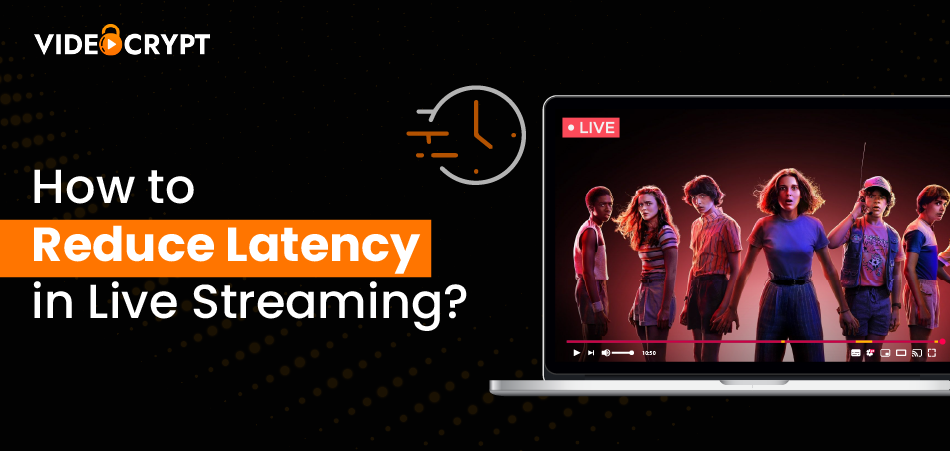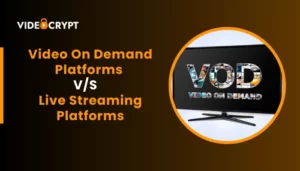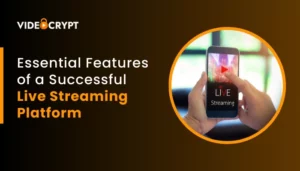Today, the popularity of live streaming has spread like wildfire, with more than 25 minutes of video-viewing time per session. Due to this, every content creator or video publisher opts for streaming live videos. Yet, the looming hurdle of latency remains a major concern for them, capable of disrupting the seamless live video experience and annoying viewers.
The latency of live videos is the culprit, causing a potential drop in quality, which results in decreased viewership and revenue. To counter this, content creators and video publishers are actively pursuing low-latency live streaming solutions to optimize the user experience and sustain financial success.
In this increasingly competitive market, streaming videos with low latency have become a necessity to provide a seamless viewing experience to the audience. Let’s dive into what low latency is in live streaming, its main causes, and how to overcome it.
So let’s get started!
Table of Contents
ToggleEverything you Need for Video Streaming is here, Sign up for Free Trial
What is Low Latency in Live Streaming?
Latency refers to the time difference between when the event occurred and when a video viewer sees it.
Low latency is the reduction in data processing delays over the internet. Furthermore, achieving a low glass-to-glass delay in live streaming has become crucial for both content creators and video publishers, especially those that are less than 5 seconds. In simple words, low latency streaming is when viewers can watch live videos within 5 seconds after being captured by the camera.
Irrespective of the high-quality live video, if a viewer is experiencing latency, then it is most likely to leave the video. A content creator or video publisher should always keep the latency of videos as low as possible to ensure viewer’s engagement with interactive and engaging live videos.

What Causes Latency of Live Videos?
The live-streaming market has witnessed tremendous growth in the past few years. However, many content creators and video publishers are struggling with real-time streaming due to latency issues. There are a variety of factors that can increase the latency of a live video. Check out this dedicated section that discusses some of the major reasons that can result in creating live video latency.
Bad Internet Connectivity
One of the common causes of low latency in a live streaming video is poor internet connection. An unstable internet connection may lead to loss of packet(s) which are dropped during data transmission. This process introduces additional latency to a video because the video player on the client side waits for the missing data.
Poor-quality Hardware
Due to poor hardware, a content creator or video publisher may face the challenge of latency of live videos. It can affect the real-time nature of a video with reduced encoding performance. If the hardware of a streaming business is underpowered, then it may cause latency in live or real-time streaming.
Bad Video Encoding
The video encoders process video-based files by compressing video data to send video signals over the internet. Due to bad encoding of a video, video quality may get compromised along with that there may be an increase in latency in a live video.
Distance between Audience & Streamer
Another factor that creates latency in a live video is the distance between the audience and the source of a video. This live video latency increases with an increase in distance due to limitations of data transmission over the internet. Data transmission involves encoding, packetizing, and sending information which chooses some paths through a network to reach its destination. The efficiency of the chosen route can be affected by an increase in the geographical distance.
Problem with CDN and Streaming Protocols
All content delivery networks are designed to optimize the content delivery process, any malfunction in CDN can cause latency in live video streaming. In addition, issues with streaming protocols and server load can significantly contribute to latency in live streaming videos.

How Latency Can Impact Live Streaming?
Latency can have a really bad effect on the performance of live video and it may lead to a decrease in its engagement. More than this, the latency can also impact live or real-time streaming for multiple reasons which are listed below.
Degraded Viewing Experience
A longer latency of a video can result in a delay between what is happening in real-time and what viewers are watching on their screens. It is particularly noticeable during live sporting events, video game streams, and other interactive live shows. It can annoy any viewer and reduce video engagement.
Interruption in Video Communication
In a situation where two-way communication takes place like a video conference, real-time streaming is necessary. Any latency can cause inconvenience to the users on either or both sides and irritate them as well by disrupting the flow of conversation and coordination leading to a business getting bad reviews and feedback.
Low Video Quality
Low latency live streaming enables a streaming business to deliver live videos in their intended resolution, providing viewers with a visually pleasing experience. An absence of it can easily hamper the video quality of a live stream.
Poor Video Game Streaming Experience
The low latency of live videos is crucial to ensure flawless real-time interactions between the streamer and the audience. Here, any delay can easily impact the viewer’s ability and make the video game viewing experience less immersive.
Furthermore, the lack of low latency live streaming can also make a business lose billions of dollars of revenue. It will hinder the growth of revenue of a streaming business.
How to Reduce Live Streaming Latency?
Today, every video publisher or content creator is looking for a perfect solution that can help them reduce the latency in a live video. They can effectively do it by incorporating some of the methods that are listed below.
Correct Video Streaming Partner
There is a tremendous growth in the demand for low latency live video streaming. Therefore, both content creators and video publishers seek support from a professional video streaming partner. This partner will use new-age live streaming protocols like WebRTC or LLHLS (Low Latency HLS).
Select the Correct CDN
Reduce latency in video content delivery by using Amazon CloudFront-a global content delivery network (CDN). This CDN has 600+ Points of Presence (PoPs) to distribute content at low latency with automated network mapping and intelligent routing.
Also Read: VideoCrypt – Best Alternative to Cloudflare for Content Delivery
Optimize Encoder Settings
Using video encoders in high-quality settings will demand data to be processed at a faster rate. So a video publisher needs to adjust the encoding settings to balance video quality & latency problems. Here, lowering the bitrate can help to reduce the latency of live streaming videos.
Use Amazon IVS
One of the best solutions to lower the latency of live or real-time streaming is the use of Amazon IVS. It is a managed live streaming solution that helps a content creator or video publisher deliver engaging live streams at low latency. This solution will enable video viewers to watch live videos with a glass-to-glass latency of 2 to 3 seconds.
Also Read: Everything you need to know about Amazon IVS in 2023

How VideoCrypt Can Help to Reduce Latency in Live Streaming?
VideoCrypt is a secure and interactive video streaming solution that enables customers to use live or real-time streaming to address core customers’ needs. It focuses on reducing the video latency of live or real-time streaming through Amazon IVS which helps a video publisher to live stream at a low latency. In addition to Amazon IVS, VideoCrypt also uses a global CDN which is Amazon CloudFront. It helps in streaming of live events without delay, especially during the broadcasting of live events. Therefore, when VideoCrypt’s live streaming platform is used, viewers experience a reduced delay in watching live videos.
Conclusion
The world of live or real-time streaming is continuously changing and is driven by an increasing demand for low-latency video viewing. In turn, video publishers and content creators are looking for a perfect live streaming platform. This platform will help them to stream live videos at low latency so they can connect with their target audience in real-time. Moreover, it can also assist a streaming business in driving more engagement and revenue through low latency live streaming.
 Offer 1 month Unlimited streaming VOD & Live with VideoCrypt Mobile App For Educational institute and Youtube Creators*
Offer 1 month Unlimited streaming VOD & Live with VideoCrypt Mobile App For Educational institute and Youtube Creators*




